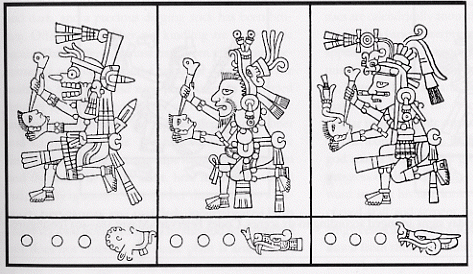Apparently, what irritated the friars so much about the indigenous religion was the fact that the natives would bail out of Mass the moment one of their holy men said that it was a propitious time for them to be tilling the fields, harvesting the maiz, or having a baby. It might have been that, or it might have been the two time cycles --- one your regular 365-1/4-days-in-the-year, the other a 260 day period which (it was thought) might have been inspired by the Mixtec priestesses --- since 266 days, as we all know, is the time needed for a mother, as they say in Spanish, "dar a luz" ... to give a child to the light. Maybe the good fathers from Madrid and Málaga and CadÝz couldn't stand the spelling. When they spoke of the heathen gods, they were required to say "Tonacatecuhtli" (the big one) or, for the duo of the underworld, "Tonalamatl" or "Tlazolteotl." Then there were "Mictlantecuhtli" and "Mictlancihuatl" and "Xiuhtecuhtli" and --- the highest of them all --- "Quetzalcoatl." How can you curse another man's religion when you can't even figure out the system, much less pronounce the names of their divines? Much better to just burn their goddamn books.
Boone has come up with a fairly complete compilation of the codices, with gorgeous illustrations, twelve in color, almost 150 in black and white. If you want to do some divination on your own with these, forget it. Like any human representation of the divine, these are so complex as to be useless, especially for those of us who had trouble figuring out how to throw the three coins for the Book of Changes, much less tossing the yarrow stalks, understanding "Yin" and "Yang" ... or whatever it was that let us know if we should go home for Easter Weekend or stay on at university and get blind on Purple Passion.
